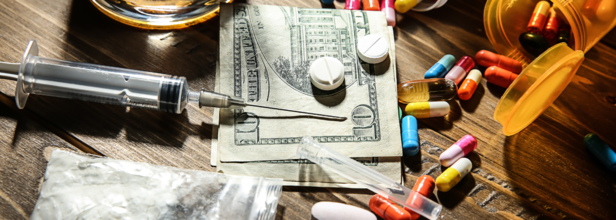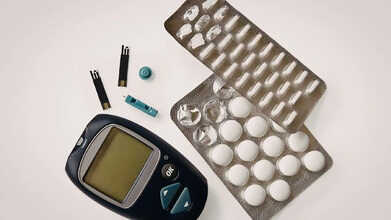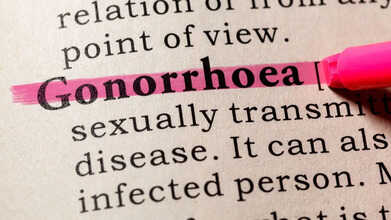- Health Conditions A-Z
- Health & Wellness
- Nutrition
- Fitness
- Health News
- Ayurveda
- Videos
- Medicine A-Z
- Parenting
What Are The Most Abused Drugs In The US?

Credits: Canva
Drug abuse is a serious problem, which is capable of not only causing death to the one using it, but create a havoc in the lives of those who are associated with that person too. There have been plenty cases, whether it is Matthew Perry or the recent death of Liam Payne, which is in trial currently.
It is also a problem in the US and is emerging as one of the health concerns that could destroy families and society. One of the most alarming aspects of drug abuse is also its impact on public safety as well as increased crime rates. Drugs also take a heavy toll on healthcare systems as emergency departments frequently encounter cases of drug overdoses, which puts the burden on medical professional who have the strain the limited resources available.
There are also long-term health impact due to drug abuse, which includes organ damage, infectious disease, mental health disorders and rise in healthcare cost.
Are there any specific drugs which are most abused in US?
Yes. There are commonly used drugs, which also includes prescribed painkillers like oxycodone, hydrocodone, and fentanyl, as well as illicit substances like heroin. As per recent data, opioid abuse has also reached alarming levels which has affected millions of Americans.
Here are the most abused drugs in the US:
Stimulants
They are used to increase alertness, attention, and energy. They also have a high potential for abuse due to the euphoric and performance enhancing effects. Cocaine and methamphetamine are notable stimulants frequently abused in the US. As per 2019 data, 10.3 million people reported to misuse stimulants in the previous year.
Depressants
These substances are used to slow down brain activity and induce relaxation. Benzodiazepines is one of the commonly prescribed medicine. Around 4.8 million individuals in the US have misused this drug.
Other misused drugs and its affects on the health:
Opioids:
It could lead to slow breathing and heart rate. It can also increase the risk of overdose and respiratory failure, constipation and a weakened immune system.
Stimulants:
It can elevate heart rate and blood pressure. It could also increase body temperate and lead to an irregular heartbeat. Furthermore, one can experience loss of appetite and weight loss.
Cannabis:
This can alter perception and coordination. People who consume it often have red eyes and a dry mouth. This can increase appetite, sometimes the "munchies" can reach to a point of no return and it could impair memory and cognitive function.
Benzodiazepines:
It could lead to sedation and drowsiness and an impaired coordination and balance. There also could be memory problems and confusion, along with respiratory depression, when combined with other depressant substance.
Alcohol:
This could lead to slurred speech, impaired condition, poor judgment and decision-making, liver damage and cirrhosis and an increased risk of accidents and injuries, which is the 3rd most leading cause of death in the US.
Additional Negative Impact: Social and psychological
Substance abuse impairs job performance and reliability, leading to frequent absenteeism, reduced productivity, and even job loss. This further leads to financial instability, strained relationships, and a cycle of dependency.
What Is Type 5 Diabetes? All You Need To Know About The Newly Identified Condition

Credits: Canva
A newly recognised form of diabetes is reshaping how scientists and doctors view the condition, particularly in countries like India. In 2025, global health authorities officially acknowledged Type 5 diabetes as a separate and distinct form of the disease.
This recognition ended decades of confusion around a type of diabetes that did not fit neatly into the existing categories of Type 1 or Type 2 diabetes. The formal classification, backed by the International Diabetes Federation and supported by research published in The Lancet Global Health, is expected to transform diagnosis, treatment, and long-term care for millions of people worldwide.
But what exactly is Type 5 diabetes, and how does it differ from the types of diabetes that are more widely known?
What Is Type 5 Diabetes?
Type 5 diabetes is now recognised as a distinct form of the disease caused primarily by severe, long-term malnutrition, often experienced during childhood. This undernutrition can lead to profound insulin deficiency and an underdeveloped pancreas, resulting in significantly reduced insulin production.
Unlike Type 1 diabetes, which is autoimmune, or Type 2 diabetes, which is linked to insulin resistance, Type 5 diabetes arises from nutritional deficiencies that impair the pancreas’s ability to function properly.
It most commonly affects lean young adults in low-income regions. For years, people with this condition were misdiagnosed as having Type 1 diabetes or an unusual form of Type 2, often leading to inappropriate treatments that failed to address the root cause.
Type 5 Diabetes Symptoms
Symptoms of type 5 diabetes can resemble those seen in other forms of diabetes, such as excessive thirst, frequent urination, persistent tiredness, unexplained weight loss, blurred vision, and slow-healing wounds. However, they are often paired with indications of malnutrition, including a lean physique, delayed growth or puberty in young people, anemia, and recurring infections.
These arise from nutritional deficiencies during early life rather than solely from insulin resistance or autoimmune causes, and they usually present before the age of 30, according to the International Diabetes Federation.
Type 5 Diabetes: Scientists Demand Recognition
Researchers have been studying this condition for decades, particularly in parts of Asia and Africa. Yet, without official recognition, the disease remained poorly understood, and patients were rarely diagnosed correctly. Experts argued that grouping these patients under existing categories obscured the true cause of their illness.
The 2025 classification now formally separates Type 5 diabetes from other types, making it easier to study, identify, and manage. In India, where diabetes prevalence is already high, this recognition is particularly relevant. Tens of millions of people live with diabetes in the country, many of whom remain undiagnosed. Type 5 diabetes highlights a different pattern: it develops not from excess calories, but from too little nutrition during childhood, creating a double burden in regions where obesity and undernutrition coexist.
Implications for Diagnosis and Care
Although there is no new treatment specifically for Type 5 diabetes yet, official recognition marks a major step forward. Doctors can now approach lean patients with a history of malnutrition more carefully, avoiding a “one-size-fits-all” approach. Clearer classification could lead to better guidelines, more personalised care, fewer complications, and improved long-term outcomes.
Experts believe that understanding the role of childhood undernutrition in diabetes could eventually reshape how we prevent, monitor, and manage the condition—something countries like India urgently need as diabetes numbers continue to rise.
This Common Cold Like Symptom Might Actually Be An Early Sign Of Dementia

Credits: Canva
An early sign of dementia can sometimes look like a common winter-related issue. When this symptom appears along with other warning signals, it may be wise to speak to a doctor. Dementia is a syndrome marked by a collection of related symptoms that point to a gradual decline in brain function. Over time, this can affect memory, behaviour, thinking, and even movement. In its early phase, however, dementia often shows up through subtle changes that are easy to overlook or mistake for something less serious.
This Common Cold Like Symptom Might Actually Be An Early Sign of Dementia
Dementia UK notes that one possible early indicator of dementia is “low mood, anxiety or depression”. Its specialists explain: “In the early stages of dementia, people often begin to notice symptoms that interfere with day-to-day life.” The difficulty is that low mood or depression can also be linked to seasonal affective disorder (SAD), a form of depression that tends to appear during winter and ease as the days become longer and brighter.
Symptoms of Seasonal Affective Disorder (SAD)
The NHS lists the following possible symptoms of SAD:
- Low mood
- Loss of interest in activities you usually enjoy
- Feelings of guilt, hopelessness or worthlessness
- Feeling restless, tense or easily irritated
- Problems with concentration
- Increased appetite and eating more than usual
- Feeling very tired and sleeping more than usual
- Thoughts of suicide or self-harm
Dementia Early Symptoms
Dementia UK also highlights other possible early signs of dementia, including:- Problems with memory and concentration
- Difficulties with language and communication, such as struggling to find words or follow conversations
- Difficulties with planning, problem-solving and making decisions
- Getting lost in familiar places because of problems with orientation and reduced ability to recognise usual cues, such as signs or landmarks
- Changes in behaviour and personality, such as becoming more withdrawn or less patient
How Early Symptoms May Differ Between Dementia Types
The organisation explains: “A person experiencing early symptoms of dementia may notice these changes themselves, or they may be picked up first by family members, friends or colleagues. Memory problems are not always obvious in the early stages of some types of dementia, such as frontotemporal dementia, where changes in behaviour and personality may appear first.
“People with young onset dementia, where symptoms begin before the age of 65, are also less likely to have memory loss as an early symptom.”
Emotional Changes Linked To Specific Forms Of Dementia
The charity also points out that emotional changes can be linked to two specific types of dementia. In vascular dementia, a person may experience “changes in mood, behaviour and personality”, while Lewy body dementia can cause “mood changes, including anxiety and depression”.
Dementia: Why These Symptoms Can Be Hard To Identify
That said, it is often difficult to know at first whether dementia is the cause of these warning signs. Dementia UK advises: “Many symptoms associated with dementia can also be caused by other physical or mental health conditions, such as thyroid disorders, menopause, vitamin B12 deficiency, depression, anxiety, work-related stress or relationship difficulties.
“This means that experiencing symptoms linked to dementia does not automatically mean someone has the condition. However, if you or someone close to you is showing signs or symptoms of dementia, it is important to visit a GP to understand what might be causing them.”
When To Seek Medical Advice
If you or someone you know is showing symptoms that resemble dementia, seeking advice from your GP is an important first step.
FDA Clears First New Gonorrhea Drug In 30 Years Amid Growing Antibiotic Resistance

Credits: Canva
Gonorrhea poses a far more serious challenge than many realise. Over the years, doctors treating the infection have seen their treatment choices steadily shrink. The bacteria responsible, Neisseria gonorrhoeae, has repeatedly adapted to antibiotics, rendering many once-reliable drugs ineffective. As a result, clinicians have been forced to depend heavily on a single injectable medication, a situation that has raised growing concern.
That dependence is becoming increasingly risky. Data from the US Centers for Disease Control and Prevention show that reported cases of gonorrhea, chlamydia, and syphilis have climbed by nearly 90% since 2004. In 2023 alone, the country recorded more than 2.4 million cases of sexually transmitted infections.
FDA Clears First New Gonorrhea Drug In 30 Years
This month, however, marked a significant shift. The US Food and Drug Administration approved two new oral antibiotics to treat gonorrhea: zoliflodacin and gepotidacin. These approvals represent the first entirely new gonorrhea treatments in more than three decades.
“These approvals mark a significant milestone for treatment options for patients with uncomplicated urogenital gonorrhea,” said Dr Adam Sherwat of the FDA in an official statement.
Why Gonorrhea Has Become Harder to Treat
If left untreated, gonorrhea can lead to serious complications, including pelvic inflammatory disease, infertility, and in rare cases, infections that spread to the joints or bloodstream, as per Cleveland Clinic. Many people experience no symptoms at all, allowing the infection to spread quietly. Despite years of research, there is still no licensed vaccine, leaving antibiotics as the primary line of defence.
What the FDA’s Decision Changes
The newly approved treatments offer a fresh sense of hope. Zoliflodacin, developed by the nonprofit Global Antibiotic Research and Development Partnership in collaboration with Innoviva Specialty Therapeutics, is designed as a single-dose oral medication. Gepotidacin, developed by GSK, is taken in two doses and is also approved for treating certain urinary tract infections.
Both medicines eliminate the need for injections, a shift that could make treatment simpler and more accessible, particularly in settings where access to clinics is limited.
FDA Clears First New Gonorrhea Drug: How the Two New Medicines Work
As per Medscape, clinical trial results for both drugs have been encouraging. Zoliflodacin was tested in a large international study involving more than 900 participants across Europe, Africa, Asia, and the US. The drug successfully cured about 90.9% of patients, a rate comparable to the 96.2% success rate of the current injectable standard. Most reported side effects were mild.
Gepotidacin showed similarly strong results in a separate Phase 3 trial that included around 600 patients from six countries. The cure rate reached 92.6%. Some participants reported digestive issues, but these effects were generally described as mild.
What the Trial Results Show
Importantly, both medications were effective against strains of gonorrhea that no longer respond to older antibiotics. That said, public health experts stress that these drugs are not a permanent solution.
“Bacteria are smart. They can pass resistant mechanisms between each other,” said Dr Manica Balasegaram of the Global Antibiotic Research and Development Partnership, speaking to CNN.
Why Experts Say Caution Is Still Needed
Several uncertainties remain. Neither drug has yet shown strong effectiveness against throat infections, known as pharyngeal gonorrhea, which are more difficult to detect and treat. There is also ongoing debate about how best to use the new medications. Some experts argue they should be reserved as last-line treatments, while others believe earlier use could help slow resistance.
Dr Tereza Kasaeva of the World Health Organization described the approvals as “an important and timely development” amid rising global infection rates and limited treatment options, according to The Guardian.
For now, the new drugs provide much-needed breathing room. Whether that progress holds will depend on careful prescribing and close monitoring of how resistance evolves.
© 2024 Bennett, Coleman & Company Limited

